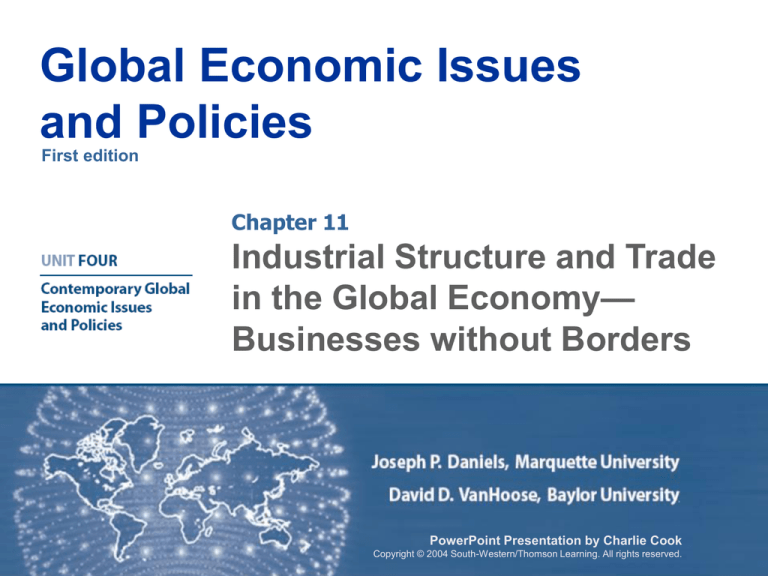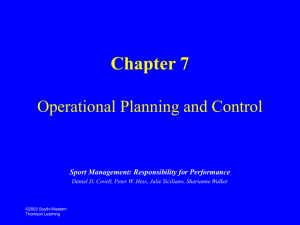
Global Economic Issues
and Policies
First edition
Chapter 11
Industrial Structure and Trade
in the Global Economy—
Businesses without Borders
PowerPoint Presentation by Charlie Cook
Copyright © 2004 South-Western/Thomson Learning. All rights reserved.
1. How do economies of scale help to explain a
nation’s specialization in inter-industry trade?
2. How do economies of scale and product variety
provide an explanation for intra-industry trade?
3. In what way can foreign direct investment affect
international trading patterns?
4. What are alternative industry structures, and how
does industry structure matter in the global
economy?
Copyright © 2004 South-Western/Thomson Learning. All rights reserved.
11–2
5. Why do companies engage in cross-border
mergers and acquisitions, and how do
international market linkages complicate
measuring the degree to which a few large firms
may dominate markets?
6. How do governments regulate international
merger and acquisition activities?
Copyright © 2004 South-Western/Thomson Learning. All rights reserved.
11–3
Industrial Organization and International
Integration
• Industrial Organization
The study of the structures of and interactions among
firms and markets.
• Why Study Industrial Organization?
The significant growth of intra-industry trade that
primarily entails the international exchange of goods
or services that are close substitutes.
Copyright © 2004 South-Western/Thomson Learning. All rights reserved.
11–4
Economies of Scale and International Trade
• Long-run Average Cost
The ratio of a firm’s total production cost to its output
when the firm has sufficient time to vary the quantities
of all factors of production.
• Economies of Scale
A reduction in long-run average cost induced by an
increase in a firm’s output.
Specialization
in the use of factors of production due to
an increase in the scale of production
The savings advantage of physical processes that
produce more output with proportionately fewer inputs.
Copyright © 2004 South-Western/Thomson Learning. All rights reserved.
11–5
Figure 11-1
A Hypothetical Long-Run Average Cost Curve for an Aircraft Industry
Copyright © 2004 South-Western/Thomson Learning. All rights reserved.
11–6
Economies of Scale and International Trade
(cont’d)
• Diseconomies of Scale
An increase in long-run average cost caused by an
increase in a firm’s output.
• Minimum Efficient Scale
The size at which a firm or industry minimizes its
long-run average cost over a time frame in which
quantities of all factors of production may be adjusted.
Copyright © 2004 South-Western/Thomson Learning. All rights reserved.
11–7
Price and Cost per Unit
Price and Cost per Unit
Price and
Cost per Unit
Figure 11-2
Demand, Production,
and Pricing at a
Monopolistically
Competitive Firm
Copyright © 2004 South-Western/Thomson Learning. All rights reserved.
11–8
Product Variety, Imperfect Competition, and
Intra-industry Trade
• Theory of Imperfect Competition
When firms sell products that are not identical yet are
substitutable, they are said to be imperfectly
competitive firms.
Any
single perfectly competitive firm that sells products
identical to those of other firms has no incentive to set a
price that differs from the market price, because setting
a price above the market price induces its customers to
buy the other identical product.
Copyright © 2004 South-Western/Thomson Learning. All rights reserved.
11–9
Types of Foreign Direct Investment
• Horizontal Foreign Direct Investment
Establishment of a foreign subsidiary of a
multinational firm that produces a good or service
that is similar to the one the firm produces in its
home country.
• Vertical Foreign Direct Investment
Establishment of a foreign subsidiary of a
multinational firm that produces components that
are assembled elsewhere or uses components
produced elsewhere to assemble the firm’s final
product.
Copyright © 2004 South-Western/Thomson Learning. All rights reserved.
11–10
Product Variety, Imperfect Competition, and
Intra-industry Trade (cont’d)
• Monopolistic Competition
An industry structure with a relatively large number of
firms, easy entry or exit, and similar but not identical
firm products.
In
the short run, a firm can earn a positive economic
profit, which means that its total revenue can exceed
the opportunity cost of being part of that industry
instead of another industry.
In the long run, the total revenue earned by a firm in a
monopolistically competitive industry just covers the
opportunity cost of remaining in the industry.
Copyright © 2004 South-Western/Thomson Learning. All rights reserved.
11–11
Trade Effects of Foreign Direct Investment
• Foreign Direct Investment
Horizontal investment is used as a means of avoiding
barriers to trade within other nations.
Vertical investment allows firms to transfer
components from facilities in one nation to another.
• First-Mover Advantage
A barrier to entry arising from the ability of the initial
firm in an industry to develop marketing advantage by
identifying its own product as the industry product.
Copyright © 2004 South-Western/Thomson Learning. All rights reserved.
11–12
Globalization and Industry Structure
• Barriers to Entry
Any factors inhibiting entrepreneurs from
instantaneously founding a new firm.
The
presence of significant economies of scale.
Exclusive ownership of a relatively large portion of a
key resource used to produce a good or service.
Differences among products that help explain
monopolistic competition.
Governmental sanctioning government-sponsored
firms or by establishing licensing requirements for an
industry and then restricting the number of licenses.
Copyright © 2004 South-Western/Thomson Learning. All rights reserved.
11–13
Alternative Forms of Imperfect Competition
• Oligopoly
An industry structure in which a few firms are the
predominant suppliers of the total output of an
industry
Their pricing and production decisions (strategic
pricing) are interdependent (oligopolistic
interdependence.
• Monopoly
An industry that consists of a single firm.
Copyright © 2004 South-Western/Thomson Learning. All rights reserved.
11–14
Figure 11-3
The Effects of Intra-Industry Trade under Monopolistic Competition
Copyright © 2004 South-Western/Thomson Learning. All rights reserved.
11–15
Figure 11-4
Comparing Monopoly with Perfect Competition with Constant Marginal
Cost
Copyright © 2004 South-Western/Thomson Learning. All rights reserved.
11–16
Figure 11-5
Domestic Dumping by a Foreign Monopoly
Copyright © 2004 South-Western/Thomson Learning. All rights reserved.
11–17
Assessing Market Concentration and Its
Effects
• Concentration Ratio
The share of total industry sales by the top few firms.
• Herfindahl–Hirschman index
The sum of the squares of the market shares of each
firm in an industry.
• Relevant Market
The true economic marketplace taking into account
the availability of all products that directly constrain
product prices for individual producers.
Copyright © 2004 South-Western/Thomson Learning. All rights reserved.
11–18
Antitrust in an Evolving Global System
• Antitrust Laws
Statutes designed to achieve benefits of competition
for consumers and producers.
• Price Discrimination
Charging different consumers different prices for
identical goods or services, or charging the same
consumer different prices for the same good or
service depending on number of units that the
consumer purchases.
Copyright © 2004 South-Western/Thomson Learning. All rights reserved.
11–19
Antitrust in an Evolving Global System
(cont’d)
• Predatory Pricing
A situation in which a firm sets artificially low prices
intended to induce competitors to leave the industry
and to dissuade potential rivals from entering the
industry.
• Industrial Policies
Government policies intended to promote the
development of specific national industries.
Copyright © 2004 South-Western/Thomson Learning. All rights reserved.
11–20
Questions and Problems- 10)
Table Key: Sales are in millions of units of the national currency; % denotes percentage of domestic and foreign share of total domestic
sales, rounded to the nearest tenth of one percentage point; %2 denotes squared percentage of market share of sales, rounded to the
nearest whole number.
Copyright © 2004 South-Western/Thomson Learning. All rights reserved.
11–21







